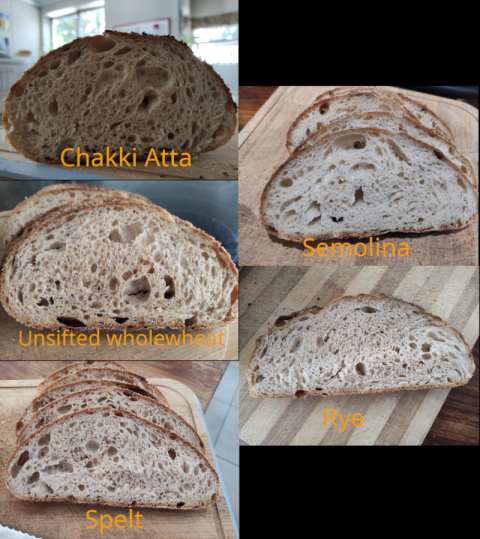
The 20 percent experiment
The last few loaves have been an experiment in varying the flour that is used together with a white bread flour base. All of these breads are 80% white bread flour; the experiment is in varying the remaining 20% to be either chakki atta (Indian stoneground wholewheat), unsifted wholewheat (without germ), wholegrain spelt, semolina or rye.
All breads had a hydration of 80% and were made according to the Full Proof basic open crumb recipe, however a machine mixer was used to incorporate the levain and salt. The remaining steps were true to the recipe, including lamination, coil folds and waiting for the dough to rise to a volume increase of between 55 and 85%, followed by overnight cold retard. The white bread flour used was "champagne valley" which has a protein content of 11.7% by itself, so vital wheat gluten was used to increase that protien content in order to support the 80% hydration (final protein was 14.9%). The levain used for all was 90% white bread flour and 10% rye.
Some flours were much harder to work - the spelt dough was extremely sticky. The semolina was particularly tiny, had a glossier texture than the others and made the best toast. The rye was super soft and spongy (and maybe the atta, wholewheat and spelt would fit into the spongy group too). A tighter shaping seemed to have been achieved with chakki atta and wholewheat, probably because they absorbed more water, and my personal favourite was the unsifted wholewheat, but it is hard to remember and it might have been more accurate to compare side by side rather than relying on my fallible memory of how they tasted.
All of these breads were lovely to eat, and weren't as different from each other as I'd originally figured. It has been a good learning experience knowing what each flour brings to the bread by itself, and also I realise that 20% can change the bread, but not as much as a higher percentage does and so they are all still white breads, albeit with a uniquely different twist in each case.



Comments
That’s a great way to learn the differences in different flours Jon, something I should have done. Interesting that at 20% it is hard to taste the difference. All the breads turned out well with really nice crumb.
Benny
It is always interesting to see what the different flours bring to the experience. Thank you.